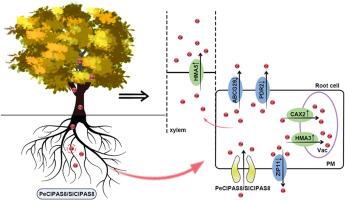镉诱导蛋白 AS8:通过镉吸收改善杨树镉积累和运输的蛋白质
IF 6.1
2区 生物学
Q1 PLANT SCIENCES
引用次数: 0
摘要
土壤重金属(HMs)污染已成为全球关注的环境问题。植物修复(即植物从土壤中提取 HMs)能以环境友好的方式有效、大幅地减少土壤中的 HMs 污染。镉诱导蛋白 AS8(CIPAS8)存在于许多植物中,其表达受到 HMs 的诱导。本研究将 PeCIPAS8 和 SlCIPAS8 转化到 84K 杨树中,研究它们对木本植物镉(Cd)耐受性和转运的影响。定位分析表明,在烟草叶片表皮细胞中瞬时表达的两个 CIPAS8 蛋白定位于质膜。与野生型 84K 杨树幼苗相比,过表达 PeCIPAS8 或 SlCIPAS8 的转基因杨树品系镉含量增加,耐镉性降低。与野生型 84K 杨树相比,过表达 PeCIPAS8 或 SlCIPAS8 的转基因杨树品系在无性期镉胁迫下,根、茎和叶中积累了更多的镉,但植株高度没有显著差异。与野生型相比,CIPAS8 提高了转基因杨树根部的镉吸收率,并影响了其他金属转运体的转录水平。这些研究结果表明,CIPAS8 增加了植物组织中的镉通量,并显示了植物对镉的适度敏感性。因此,CIPAS8 是一种流入转运体,有可能增加生长在 HM 污染土壤中的木本植物对有毒 HM 的吸收。本文章由计算机程序翻译,如有差异,请以英文原文为准。

Cadmium-induced protein AS8: A protein to improve Cd accumulation and transport via Cd uptake in poplar
The pollution of soil with heavy metals (HMs) has become an environmental problem of global concern. Phytoremediation, whereby plants extract HMs from soil, can efficiently and substantially reduce HM pollution in soil in an environmentally friendly manner. Cadmium-induced protein AS8 (CIPAS8) is present in many plants and its expression is induced by HMs. In this study, PeCIPAS8 and SlCIPAS8 were transformed into 84K poplar to study their effects on tolerance to, and translocation of, cadmium (Cd) in woody plants. Localization analyses showed that two CIPAS8 proteins were localized at the plasma membrane when transiently expressed in tobacco leaf epidermal cells. Compared with wild-type 84K poplar seedlings, transgenic poplar lines overexpressing PeCIPAS8 or SlCIPAS8 showed increased Cd contents and decreased Cd tolerance. Transgenic poplar lines overexpressing PeCIPAS8 or SlCIPAS8 accumulated more Cd in the roots, stems, and leaves, but the plant height did not differ significantly, compared with wild-type 84K poplar under Cd stress during the vegetative stage. CIPAS8 increased the Cd influx rate of transgenic poplar roots compared with that of the wild type, and affected the transcription levels of other metal transporters. These findings show that CIPAS8 increases Cd flux into plant tissues and demonstrate moderate Cd sensitivity of the plant. Therefore, CIPAS8 is an influx transporter with the potential to increase the uptake of toxic HMs by woody plants growing in HM-contaminated soils.
求助全文
通过发布文献求助,成功后即可免费获取论文全文。
去求助
来源期刊
CiteScore
11.10
自引率
3.10%
发文量
410
审稿时长
33 days
期刊介绍:
Plant Physiology and Biochemistry publishes original theoretical, experimental and technical contributions in the various fields of plant physiology (biochemistry, physiology, structure, genetics, plant-microbe interactions, etc.) at diverse levels of integration (molecular, subcellular, cellular, organ, whole plant, environmental). Opinions expressed in the journal are the sole responsibility of the authors and publication does not imply the editors'' agreement.
Manuscripts describing molecular-genetic and/or gene expression data that are not integrated with biochemical analysis and/or actual measurements of plant physiological processes are not suitable for PPB. Also "Omics" studies (transcriptomics, proteomics, metabolomics, etc.) reporting descriptive analysis without an element of functional validation assays, will not be considered. Similarly, applied agronomic or phytochemical studies that generate no new, fundamental insights in plant physiological and/or biochemical processes are not suitable for publication in PPB.
Plant Physiology and Biochemistry publishes several types of articles: Reviews, Papers and Short Papers. Articles for Reviews are either invited by the editor or proposed by the authors for the editor''s prior agreement. Reviews should not exceed 40 typewritten pages and Short Papers no more than approximately 8 typewritten pages. The fundamental character of Plant Physiology and Biochemistry remains that of a journal for original results.

 求助内容:
求助内容: 应助结果提醒方式:
应助结果提醒方式:


